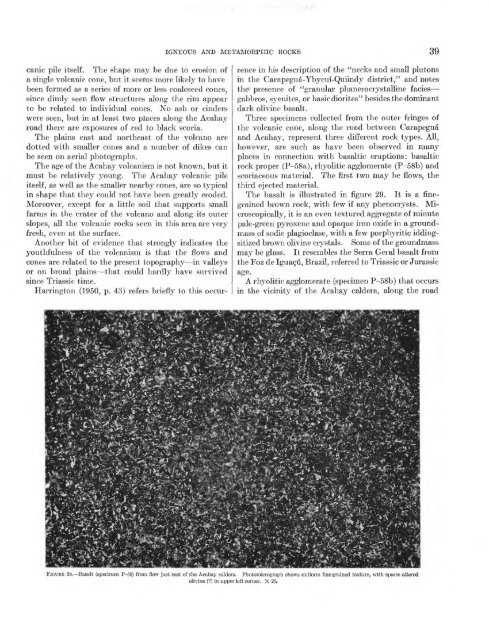Geology and Mineral Resources of Paraguay A Reconnaissance
Geology and Mineral Resources of Paraguay A Reconnaissance
Geology and Mineral Resources of Paraguay A Reconnaissance
- No tags were found...
You also want an ePaper? Increase the reach of your titles
YUMPU automatically turns print PDFs into web optimized ePapers that Google loves.
IGNEOUS AND METAMORPHIC ROCKS 39came pile itself. The shape may be due to erosion <strong>of</strong>a single volcanic cone, but it seems more likely to havebeen formed as a series <strong>of</strong> more or less coalesced cones,since dimly seen flow structures along the rim appearto be related to individual cones. No ash or cinderswere seen, but in at least two places along the Acahayroad there are exposures <strong>of</strong> red to black scoria.The plains east <strong>and</strong> northeast <strong>of</strong> the volcano aredotted with smaller cones <strong>and</strong> a number <strong>of</strong> dikes canbe seen on aerial photographs.The age <strong>of</strong> the Acahay volcanism is not known, but itmust be relatively young. The Acahay volcanic pileitself, as well as the smaller nearby cones, are so typicalin shape that they could not have been greatly eroded.Moreover, except for a little soil that supports smallfarms in the crater <strong>of</strong> the volcano <strong>and</strong> along its outerslopes, all the volcanic rocks seen in this area are veryfresh, even at the surface.Another bit <strong>of</strong> evidence that strongly indicates theyouthfulness <strong>of</strong> the volcanism is that the flows <strong>and</strong>cones are related to the present topography in valleysor on broad plains that could hardly have survivedsince Triassic time.Harrington (1950, p. 43) refers briefly to this occurrencein his description <strong>of</strong> the "necks <strong>and</strong> small plutonsin the Carapegua-Ybycui-Quiindy district," <strong>and</strong> notesthe presence <strong>of</strong> "granular phanerocrystalline faciesgabbros, syenites, or basic diorites" besides the dominantdark olivinc basalt.Three specimens collected from the outer fringes <strong>of</strong>the volcanic cone, along the road between Carapegua<strong>and</strong> Acahay, represent three different rock types. All,however, are such as have been observed in manyplaces in connection with basaltic eruptions: basalticrock proper (P-58a), rhyolitic agglomerate (P-58b) <strong>and</strong>scoriaceous material. The first two may be flows, thethird ejected material.The basalt is illustrated in figure 29. It is a finegrainedbrown rock, with few if any phenocrysts. Microscopically,it is an even textured aggregate <strong>of</strong> minutepale-green pyroxene <strong>and</strong> opaque iron oxide in a groundmass<strong>of</strong> sodic plagioclase, with a few porphyritic iddingsitizedbrown olivine crystals. Some <strong>of</strong> the groundmassmay be glass. It resembles the Serra Geral basalt fromthe Foz de Iguacii, Brazil, referred to Triassic or Jurassicage.A rhyolitic agglomerate (specimen P-58b) that occursin the vicinity <strong>of</strong> the Acahay caldera, along the roadFIOUBE 29. !(specimen P-58) from flow just east <strong>of</strong> the Acahay caldera. Photomicrograph shows uniform fine-grained texture, with sparse alteredolivine (?) hi upper left corner. X 20.
















